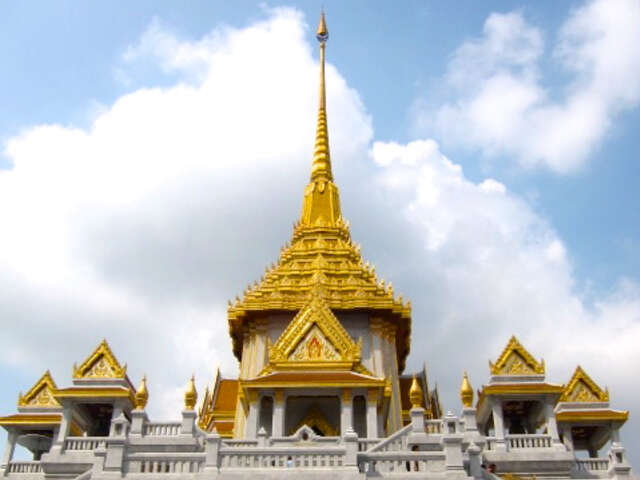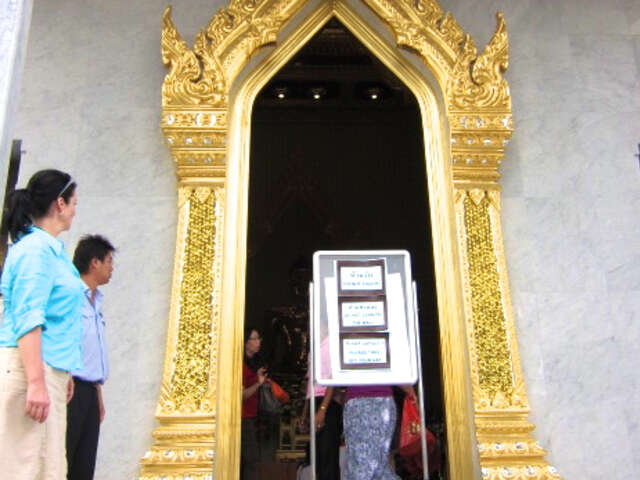Face to Face with the World's Largest Solid Gold Buddha

Most of the time, breaking an historic religious icon does not turn out well. But when workers moving a large and very old but otherwise unremarkable plaster statue of Buddha in Bangkok in 1955 dropped their load, they got lucky. The accident revealed an amazing secret: the plaster with modest inlaid glass decoration was a decoy shell concealing the world's largest solid gold Buddha.
By Lynn Elmhirst, Producer/ Host, BestTrip.TV
Hidden in Plain Sight
The design of the Buddha suggests it dates to the 13th or 14th centuries. It's believed when dangerous times were at hand during Burmese invasions in the 1700's, the solid gold statue was plastered over to cleverly hide the magnificent religious treasure in plain sight. In the confusion, dynastic changes, and moves that followed, the Golden Buddha's secret was lost to time. And so it sat under a simple open air roof in the unremarkable Bangkok temple Wat Traimit for hundreds of years – until it was dropped moving it to an indoor location.
Rather than hiding this phenomenal – and phenomenally valuable – discovery, temple officials have kept the Golden Buddha available for public worship at the temple. In 2010, they even opened a new, gold-leaf trimmed chapel to house this priceless treasure.

All photos: BestTrip.TV
That put Wat Traimit at the top of our film crew's must-visit list among the 400 temples in Thailand's capital city. Gold features prominently in Thailand's vivid national palette and design, but being face to face with the world's largest solid gold Buddha is heart-stopping. In ways we didn't expect.
Record Breaking – but Humble
It weighs 5.5 tons. And it's about 83% pure gold. That makes the gold in the statue alone worth about $250 million. The Golden Buddha's seated figure rises 15 feet above kneeling worshippers.
On arrival at the temple, you climb 4 stories of white marble steps leading to the chapel perched at the top overlooking the Bangkok skyline. Once inside, you might expect bristling guards, high tech security, crowds marched past with barely time to take a quick pic. But for a treasure of its worth and historic significance, the Golden Buddha's existence is almost humble.

The author (left) at Wat Traimit. No bare shoulders, no bare knees, and shoes off. Respecting Thai temple etiquette.
The marble and gold leafed chapel sounds extravagant, but it's quite restrained and no more spectacular than many other temple structures in Thailand. The Golden Buddha may be a tourist attraction, but not a tourist trap. Monks, local worshippers and visitors mingle. Instead of a vast hall to maximize visitor numbers (and revenue), the massive statue occupies a small room.

For visitors, that intensifies the experience. The deep reddish gold almost pulses in the way it catches dim light and warms the nearby cool white marble walls. Only a couple of dozen visitors and worshippers are able to fit inside the chapel at any given time. Worshippers place offerings and visitors can join them on a single carpet only a few feet in front of the Buddha.
It may be solid gold, but the temple monks and fellow worshippers interact with the Golden Buddha as they would any other neighborhood temple Buddha.
That might be the most remarkable part of our visit to Wat Traimit. We were expecting to be – as one of our production team said – 'wowed by the bling'. Instead, we experienced a space of beauty and almost simple serenity. As if the Golden Buddha were still hiding behind its plaster mask. Simplicity and serenity, mainstays of Buddhist practice, in the presence of what might be the most valuable and storied piece of solid gold in existence, might be the real treasure of the statue.
Start your Trip!
Copyright BestTrip.TV/Influence Entertainment Group Inc or Rights Holder. All rights reserved. You are welcome to share this material from this page, but it may not be published, broadcast, rewritten or redistributed.
by Lynn Elmhirst on 06/07/2017 in Culture & History